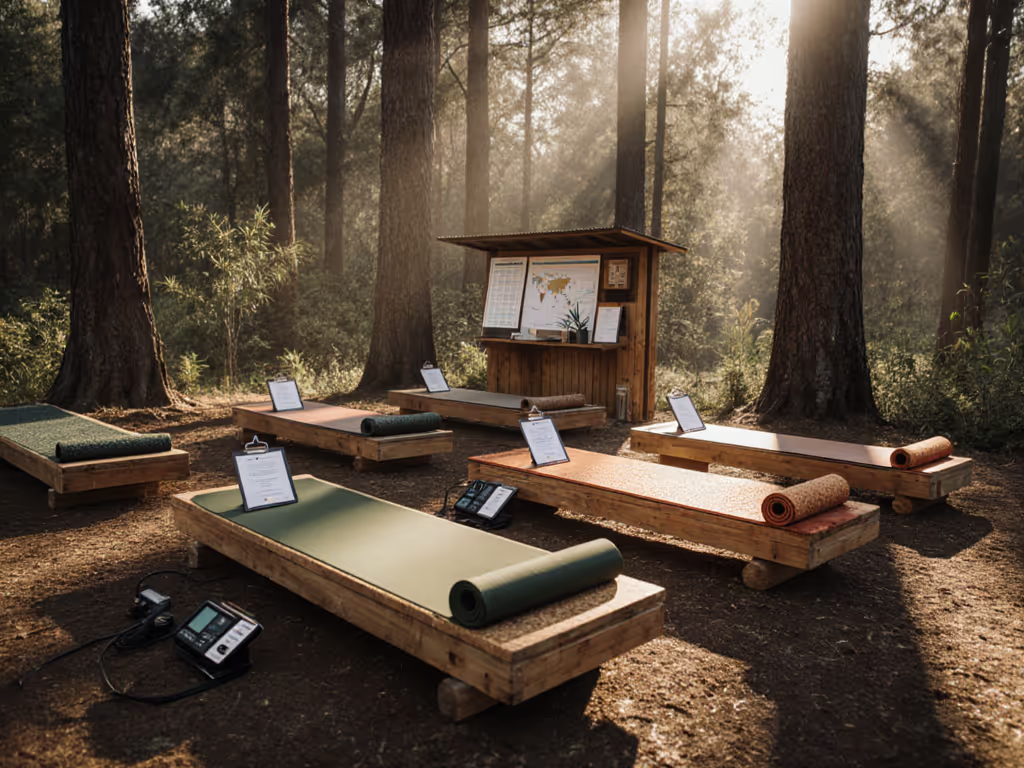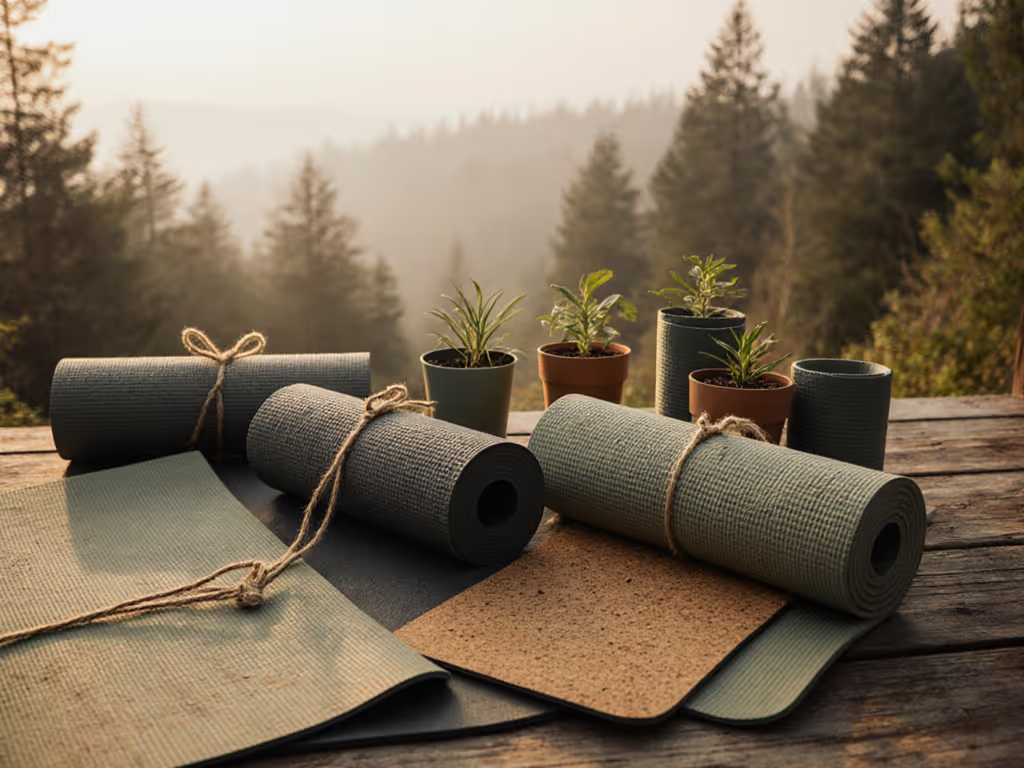
Yoga Mat Surface Grip: Science Behind Texture
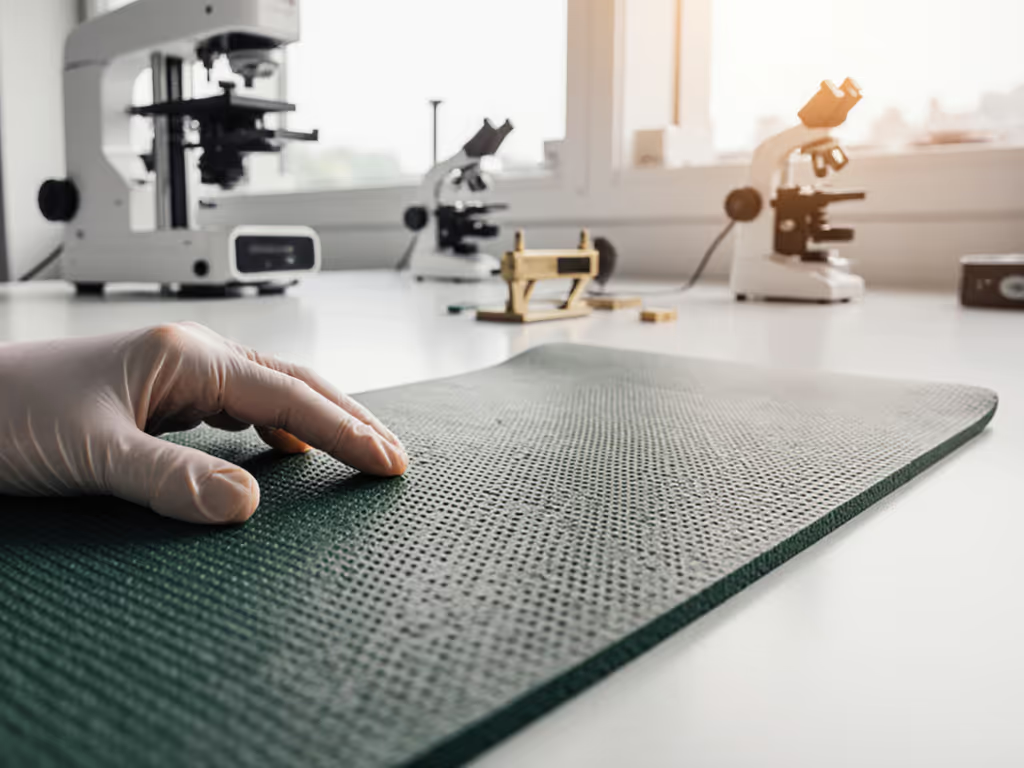
When you roll out your yoga mat, the first thing you'll notice isn't its color or thickness (it is how it feels beneath your palms). Yoga mat texture science and mat surface grip technology determine whether your practice flows or founders, making these factors more critical than most shoppers realize. As a yoga assistant who tests equipment through the biomechanical lens of joint comfort and stability, I've seen how the right grip transforms practice from a battle against slipping to a seamless expression of movement.
The Physics of Mat Surface Grip
Grip isn't magic (it is physics). If you're new to choosing a mat that actually prevents slipping, start with our beginner yoga mat guide. When you press your hand into your mat, microscopic contact points create friction that prevents slipping. This interaction follows Amontons' laws of friction, where the force resisting movement depends on both the normal force (your body weight) and the coefficient of friction between surfaces.
Three factors determine effective grip:
- Material porosity: Open-cell structures (like natural rubber) absorb moisture, while closed-cell surfaces (like PVC) repel it
- Surface topography: The pattern, depth, and spacing of textures impact how liquid moves across the surface
- Dynamic interaction: How the mat responds to pressure changes during movement
Research shows that ideal grip maintains a coefficient of friction between 0.8 and 1.2 across changing conditions. Below 0.7, hands and feet begin to slide during transitions; above 1.3, mats can feel "sticky" to the point of restricting natural movement.
Material Science Behind the Stickiness
Different materials offer varying mat surface physics characteristics that affect grip performance. Understanding these differences helps you match your mat to your practice type and sweat level.
Natural Rubber
Open-cell structure provides excellent moisture absorption. Grips better as you sweat, a rare quality confirmed by multiple laboratory tests. The molecular structure creates billions of micro-suction cups that engage when moisture is present. Natural rubber maintains a friction coefficient of approximately 1.1 even when wet, making it ideal for vinyasa and hot yoga practitioners. For material trade-offs in sweaty conditions, see our comparison of PVC vs natural rubber mats.
Thermoplastic Elastomer (TPE)
It has a closed-cell structure that relies on surface texture rather than absorption. Offers moderate dry grip (around a 0.9 coefficient) but drops to 0.6-0.7 when wet. Best for gentle practices in climate-controlled environments where sweat isn't a major factor.
Polyvinyl Chloride (PVC)
This traditional closed-cell material shows inconsistent performance. While providing decent initial dry grip (0.7-0.8), its coefficient can plummet to 0.3 when wet (nearly ice-level slipperiness). Many "sticky" PVC mats use surface coatings that degrade over time, reducing effectiveness.
Comfort is engineered: density, thickness, and floor work together.
Texture Types for Yoga: What Really Works
The pattern on your mat isn't just decorative (it is functional engineering). For real-world picks and patterns, explore the best thin mat textures for sweaty hands. Lab testing reveals significant performance differences between texture types for yoga:
Diamond Patterns: Channel moisture effectively while maintaining structural integrity. Research shows they increase wet grip by 22% compared to smooth surfaces.
Micro-Dimples: Create thousands of tiny suction points that excel in high-sweat conditions. Particularly effective for palm placement during Downward Dog and Plank positions.
Linear Ridges: Provide directional grip for specific movements but can create uneven pressure points during rotational poses.
Smooth Surfaces: Often marketed as "classic" but require moisture to activate grip properly. These work best for practices with minimal sweating or when paired with a microfiber towel.
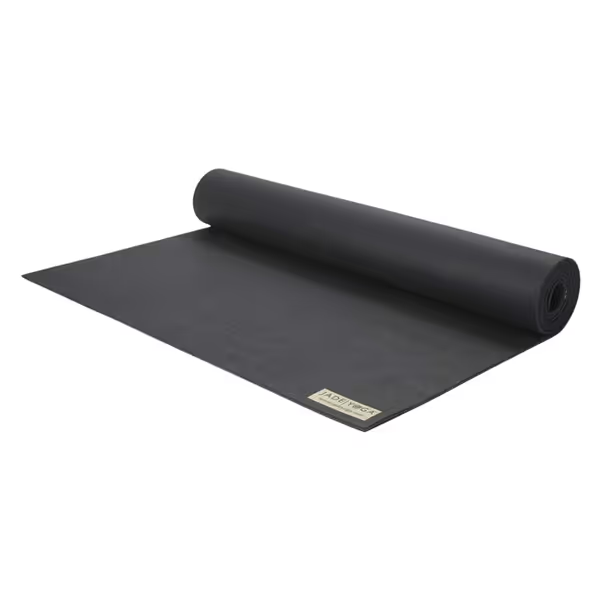
JadeYoga Harmony Yoga Mat
Scientific Grip Testing: Separating Fact from Marketing
Understanding how manufacturers test grip helps you cut through marketing hype. Reputable companies use three key methodologies in scientific grip testing:
Incline Plane Testing: Measures the angle at which a weighted hand or foot begins to slip. This simulates real-world pose transitions under varying body weights.
Horizontal Pull Testing: Determines the force required to slide a standard weight across the mat, measuring consistent resistance during movement.
Wet/Dry Comparative Analysis: Tracks performance degradation as moisture increases, crucial for hot yoga practitioners.
Independent testing reveals that many mats perform well dry but lose significant grip when wet (the exact opposite of what sweaty practices need). The best grippy yoga mat actually improves traction as moisture increases, rather than deteriorating. If you practice hot yoga, these verified non-slip hot yoga mats pass real sweat tests.
Floor-Specific Grip Considerations
Your flooring dramatically impacts mat performance (a reality I learned through trial and error in my first apartment with punishing tile floors). Tile requires different grip strategies than hardwood or carpet, creating unique challenges:
Hardwood Floors: Need mats with micro-suction bottoms to prevent mat slippage. Textured surfaces work best when paired with medium-density bases that don't bridge across uneven wood grain.
Tile Floors: Require more aggressive bottom textures to grip the slick surface. I discovered that mats with slightly tackier surfaces outperform heavily textured ones here, as grout lines can create instability with deep patterns.
Carpet: Needs mats with closed-cell bottoms to prevent fibers from interfering with grip. The right thickness matters, too thin and the mat conforms to the carpet pile; too thick and it floats above the stable base layer.
For apartment dwellers concerned about noise, consider how the mat's grip affects transition sounds. Mats that lock securely to the floor produce quieter landings during jumps and transitions, respecting neighbors below.
Practical Application: Tuning Your Mat Setup
The "perfect" mat doesn't exist (it's about finding the right combination for your specific practice, body, and environment). Drawing from my biomechanics-focused testing, here's how to optimize:
For Heavy Sweaters:
- Prioritize natural rubber or rubber-cork composites
- Choose micro-dimple textures over deep patterns
- Avoid mats requiring "break-in" periods (they're compensating for design flaws)
For Joint Sensitivity:
- Select medium-firm density that doesn't compromise ground connection
- Layer thin, grippy toppers over stable base mats rather than using single thick mats
- Test wrist placement on different textures to find pressure-point relief
For Studio Owners:
- Standardize mat types to ensure consistent grip across practitioners
- Implement pH-neutral cleaning protocols (acidic cleaners degrade rubber grip)
- Schedule mat rotation to maintain optimal performance
Tune the Dials: Cushion, Density, and Floor Compatibility
My years testing mats on diverse surfaces taught me that comfort isn't a single setting (it's a system of adjustable dials). When grip fails, don't just reach for another mat. Instead, tune these elements:
- Cushion: Adjust thickness based on joint needs without sacrificing stability
- Density: Balance softness with responsiveness to floor feedback
- Floor Compatibility: Ensure both top and bottom surfaces interact properly with your environment
I've watched students transform their practice by understanding that the JadeYoga Harmony mat's natural rubber provides exceptional grip on hardwood, while other mats might slide despite similar thickness claims. This real-world observation confirms what the physics predicts: material composition matters more than thickness alone.
Start your next practice by intentionally noticing how your hands and feet connect with your mat through different poses. Does grip remain consistent as you sweat? Does the texture support alignment without creating pressure points? Your body's feedback, combined with understanding the yoga mat texture science behind performance, creates the foundation for a truly supportive practice.
Tune the dials: cushion, density, and floor compatibility, your most stable practice awaits.
Related Articles

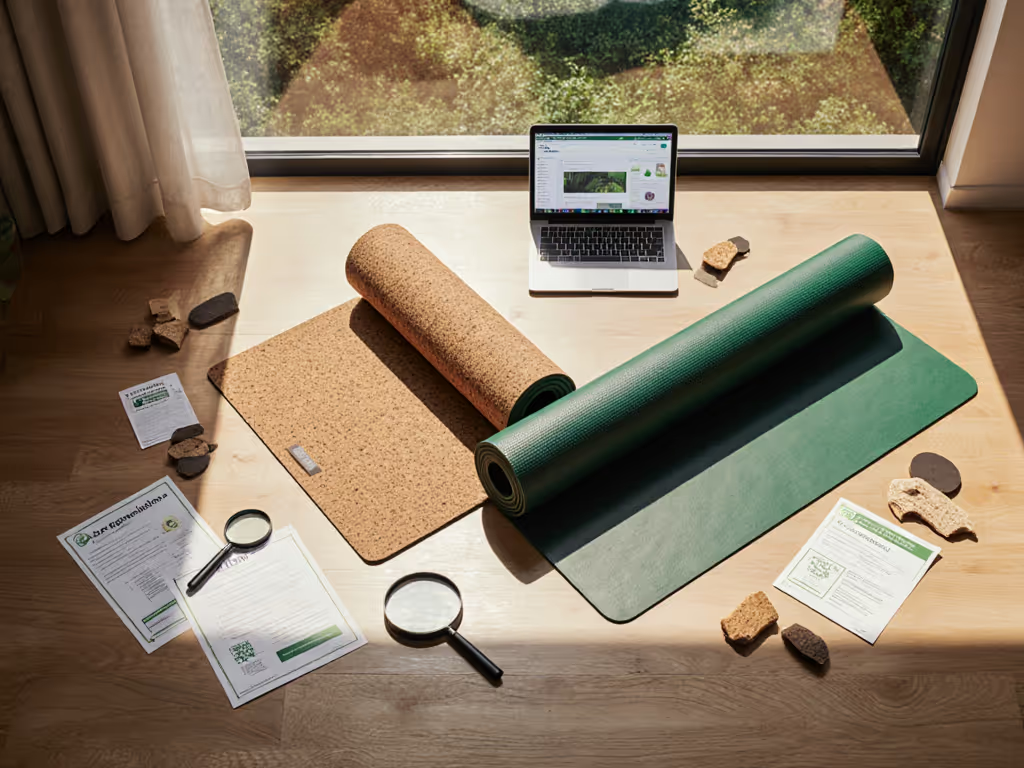
Spot Real Eco Friendly Workout Mats: Avoid Greenwashing
Skip the greenwashing and use hard checks to choose a mat that lasts: verify material sourcing (FSC rubber, full-thick cork), demand third-party VOC certifications, weigh durability metrics, and do cost-per-use math. Use the included questions to email brands so you end up with a non-toxic, grippy mat that holds up over time.
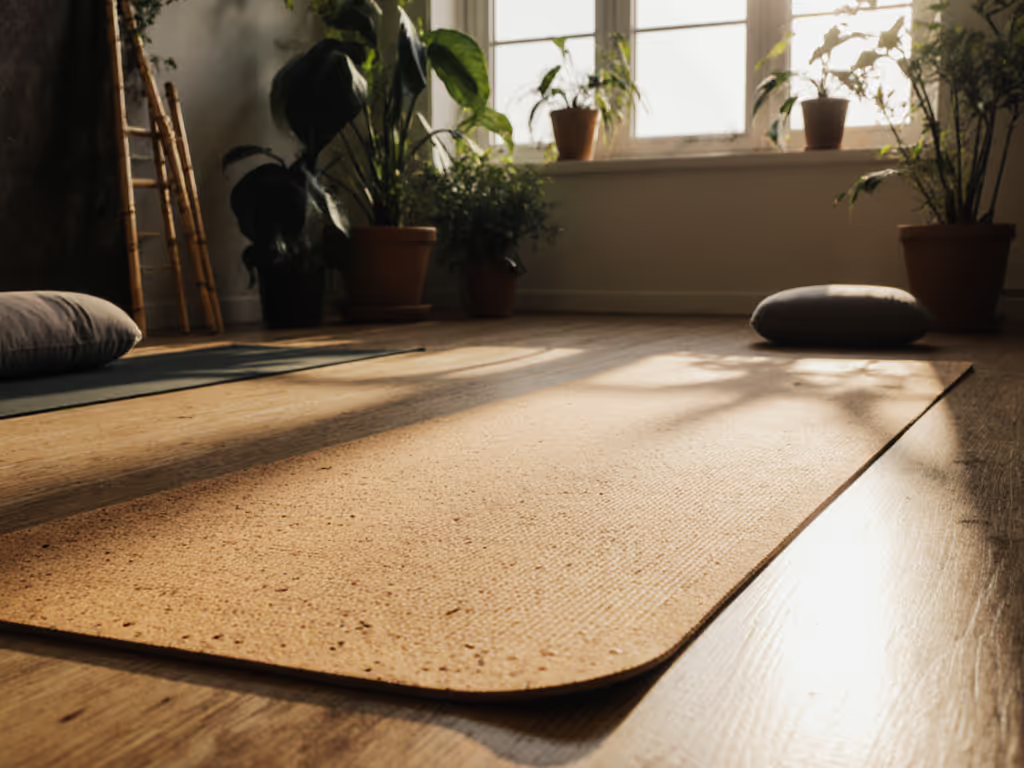
Eco Workout Mats: Non-Slip & Non-Toxic Choices Tested
Choose a safe, non-slip eco mat with confidence using lab-tested insights on grip (even when sweaty), odor/off-gassing, durability, ideal thickness, and certifications to verify. See how cork, natural rubber, and jute stack up for different practice styles and longevity.
